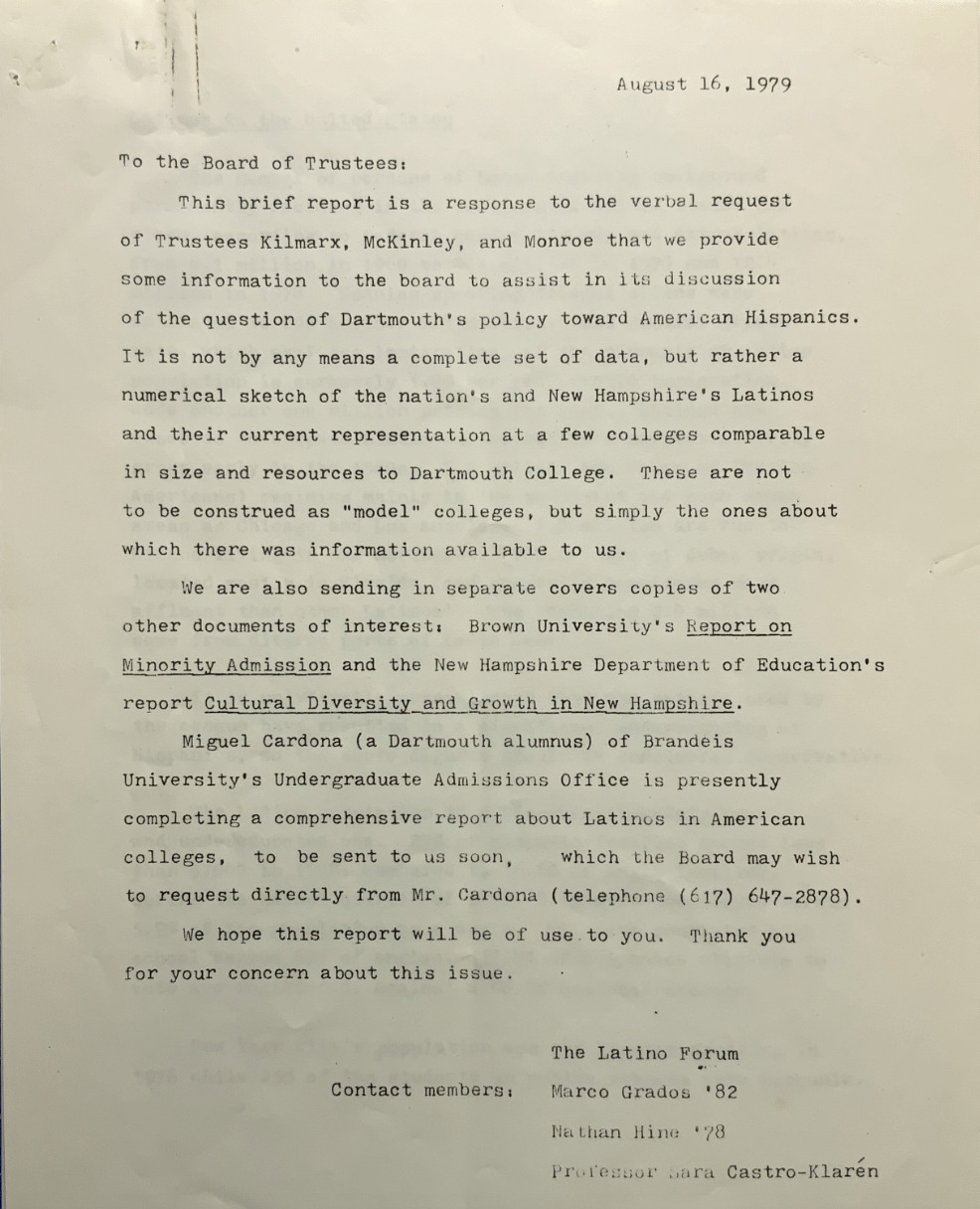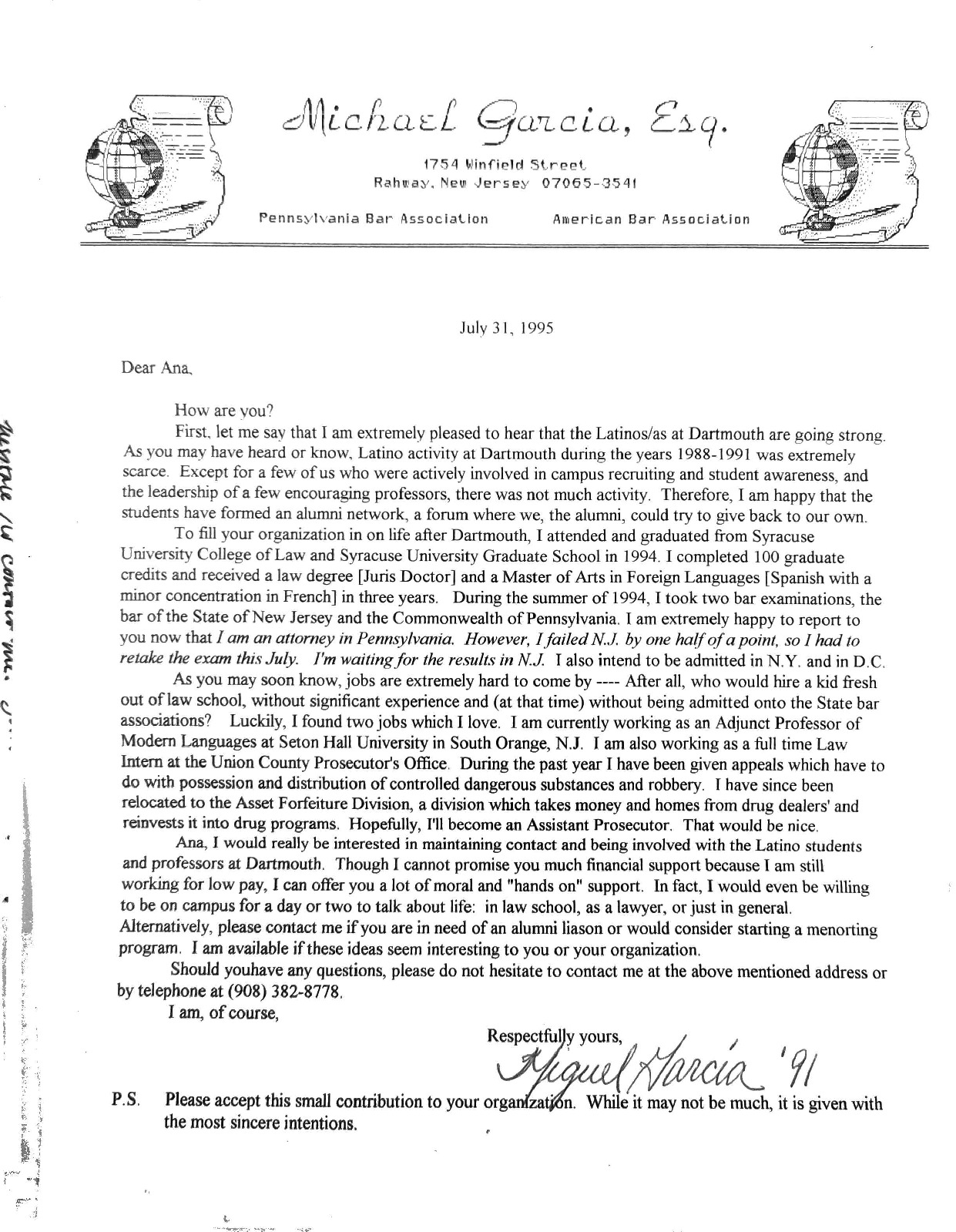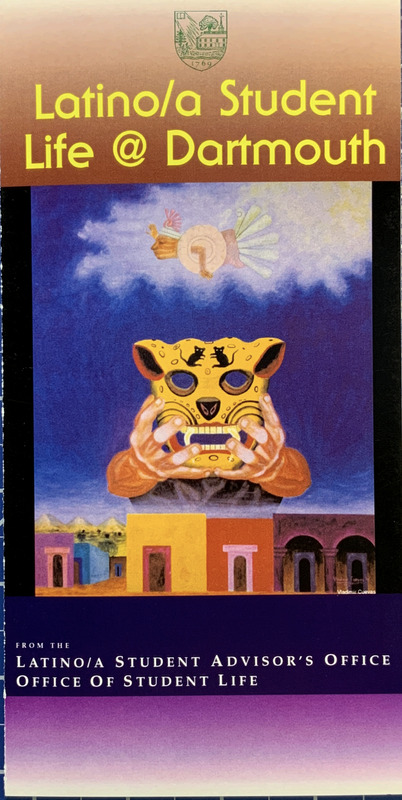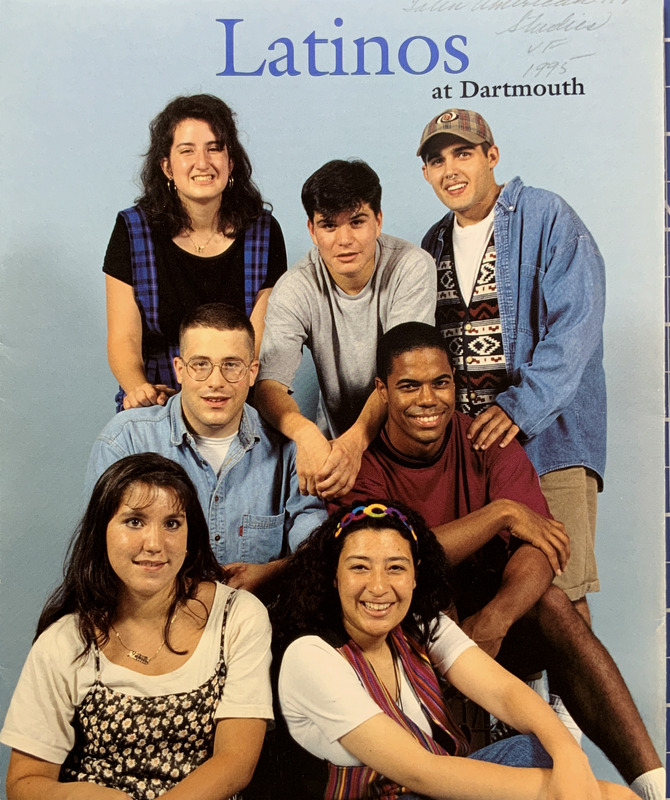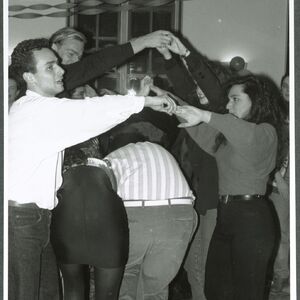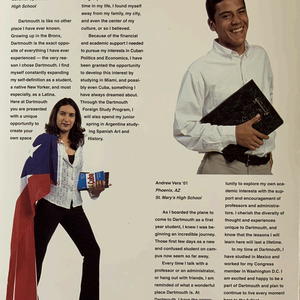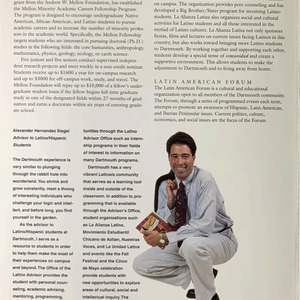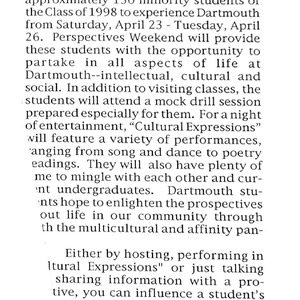Recruitment of Latinx Students by Latinx Students
Latinx students played a crucial role in bringing in prospective Latinx students in the early 1990s through various methods. While Dartmouth College voiced its support for Latinx students and laid a plan to increase Latinx student enrollment in 1986, Latinx students at Dartmouth carried out these initiatives.
Latinx students understood that in order to encourage Latinx students to apply to a predominatly white insitution (PWI) like Dartmouth College, there needs to be more resources and a support system to help this transiiton. A PWI is an insitution for higher learning where white people make up the majority of the student population.
The Latino Forum, an organization formally recognized in the spring of 1979 by the Council on Student Organizations (COSO), fought to strengthen the Latinx community at Dartmouth College. The club was the first instiutional acknowlegement of a Latinx prescence of campus. The forum’s fight came when the Chicano and Puerto Rican movements fought for social change in the 1960s and 1970s. Both movements wanted universities and programs to bring in Chicanx and Puerto Rican studies, including hiring more Latinx professors. These groups believed that Latinx people must learn their own histories, especially considering the United States' historic involvement in Latin America. The image, "Colegio is for todos," which translates to "college is for everyone," refers to a fight led by the Chicano Movement in Oregon for free tution. Income can be dividing decision in having Latinx students enroll in higher places of learning. These movments organized and held protests to fight for their demands.
Like these movements, the Latino Forum wanted to acknowledge the presence of the Latinx community already present in the community, believing in the importance of promoting and organizing social and cultural events. However, the Latino Forum focused on recruiting more Latinx students to Dartmouth considering the lack of Latinx students. Latinx students deserve to be in places of higher learning, like everyone else.
Community Building
In Johanna Fernandez’s book, The Young Lords: A Radical History, Fernandez discusses how the Young Lords, a predominantly Puerto Rican organization that fought for self-determination among the marginalized, understood the importance of community building. The organization chose a combination of political education and direct action to enact change beyond an academic setting. The Latino Forum understood the importance of bringing in this kind of education and direct action to Dartmouth’s administrators. They organized together, like these movements, to amplify their demands. While the organization brought the importance of Latinx recruitment to the attention in an academic setting, the fight goes beyond academia. Considering Dartmouth is situated near a rural town, the student body itself operates as a community because of how people can join different organizations, attend events, and expose themselves to various perspectives just by being on campus.
Inspired by their victory with COSO, the Latino Forum wrote to the college directly in the fall of 1979, challenging them for not recruiting Latinx students. By writing a letter, the Latino Forum demonstrated how it took action by presenting a demand for more Latinx students. The college developed programs to recruit Native Americans and Black people but neglected Latinx people. Considering how the Latinx population in the United States was growing rapidly, the forum found it only fitting that Dartmouth’s student population reflect this change.
“No such specific strategies have ever been made on behalf of Latinos, and the current assumption within the administration, most relevantly in the admissions office, is that it is not the Board of Trustees’ policy not to accept Latinos as a group to be recruited and supported here, or to allocate resources of funds and personnel to such recruitment and support.”
Latino Forum Report to Dartmouth, 1979
The acknowledgment of the Latinx prescence through COSO in 1979 paved the way for Latinx communities to find ways to use their voice.
Other organizations like La Alianza Latina, founded in 1985, joined in on these efforts to recruit more Latinx students, working together to reach out to the institution to get the conversation started. La Alianza Latina also sought to strengthen the Latinx community by hosting events and building a stronger community.
Institutional Acknowledgement
In 1984, Dartmouth’s Office of Admissions began to think about how it could recruit Latinx students like “Experience Dartmouth Weekend,” including working with other organizations outside of Dartmouth that work with high-achieving Latinx students. However, in the “Report of Minority Challenges: Hispanic Recruitment,” it notes that the recruitment of Latinx students should be a trustee mandate like it is for indigenous and Black people. By making it a trustee mandate, the Board of Trustees work to provide adequate resources to achieve a goal, in this case, bringing in more Latinx students.
In 1988, the Faculty of Arts and Sciences of Dartmouth College passed a motion to instruct the Committee on Admissions and Financial Aid to work towards creating a plan to recruit Latinx students. The objective was to enroll approximately 50 Hispanic students per year, effective with the Class of 1991. It took almost ten years for the Latino Forum’s dream to happen. However, the story of Latinx student recruitment does not end there. Apart from Dartmouth’s own recruitment plans, students themselves formed these programs to recruit students.
Intiatives
While Dartmouth committed to recruitment, Latinx students continued to feel alone. In a letter to Dartmouth student Anna Henderson, Michael Garcia’ 91, a Latino student, explains the lack of Latinx students in 1988-1991. He mentions that he, along with other students, worked to recruit Latinx students to Dartmouth. Few professors supported these initiatives.
In the the article,"Cultivating Campus Environments to Maximize Success Among Latino and Latina College Students,"Judy Marquez, Samuel D. Museus, and Blanca E. Vega discuss how predominantly white institutions do not provide much resources to make Latinx students feel at home. PWIs assume students themselves must adjust to the new culture themselves. Michael Garcia's testimony showcases how Latinx students were essentially left on their own to carry out Dartmouth's plan. While Dartmouth voiced its plan on bringing students together, it was up to the students to ensure Latinx students feel comfortable.
Latinx students sought to help other students adjust to the new environment. They took it upon themselves to create a support system and celebrate their culture. They understood that in order to encourage Latinx students to apply to PWIs, there needs to be a support system of students and a vibrant Latinx presence.
While Dartmouth policies claimed it welcomed Latinx students, students did not necessarily feel the same way. In a report regarding the end of fall term 1990, La Alianza lists recruitment as one of its most pressing priorities. The club discusses how Dartmouth College admissions held a panel to recruit Latinx students without having people of Latinx descent discuss their experience. This issue of lack of representation is one that Latinx students had to fight for even after the college recruited Latinx students.
Dartmouth College decided to recruit students using brochures in English and Spanish. However, these brochures featured student-created initiatives designed for students by students that use the concept of familismo, a Latinx cultural value focusing on creating and demonstrating solidarity among one another through the creation of a community. The author of this exhibit came upon this idea in Creating a College Culture for Latino Students: Successful Programs, Practices, and Strategies.
When one looks at the brochures, one can see the different marketing techniques Dartmouth College decided to engage with. Two of the brochures feature Latinx students smiling and close together. These promotional materials promote a sense of community and belonging among each other. One brochure also includes Latinx art, showcasing how the brochures are engaging with Latinx presence.
La Alianza Latina built a community with each other. The organization held events to connect Latinx students to one another and provided a safe space.
"I had never called myself a Latina, or even a Hispanic, but attending La Alianza meetings and events made me feel closer to home. At first it was the little things—hearing English spoken with a heavy accent, just like my mom, or eating platanos maduros. But I quickly realized that I felt a true kin- ship with the other Latinos. It wasn’t just the prospect of eating yuca con mojo—my favorite Cuban dish—or greeting someone with, “¿Cómo es-tás?” For the first time in my life, people were talking about living in poverty and were using those memories (for some they were more recent than for others) to bond, to come together."
Sarah Fox in Mi Voz, Mi Vida: Latino College Students Tell Their Life Stories
La Alianza Latina built a strong community for not only current students, but for prospective students as well. The brochures created to recruit Latinx students featured student-created initiatives designed for students by students that use the concept of familismo. Researchers Marquez, Museus, and Vega discuss how Latinx students used this concept in PWIs where "Latino/a peers within campus student groups as Latinos/as form a campus family or group of campus brothers and sisters.”
These brochures provided a space for Latinx students to tell their stories instead of having others tell their stories. For example, in the 1995 brochure, one student shares how they have been able to explore their interest in Cuban politics at Dartmouth.
A 1995 brochure produced by the Admissions office features how La Alianza Latina brought the Latinx community together. The organization offered peer counseling and a Big Brother/Sister program for incoming Latinx students. Having Latinx students help one another creates a community where they can understand each other considering the similar experiences they will share being marginalized students in a white institution.
“By working together and supporting each other, students develop a special sense of comunidad and create a supportive environment. This allows students to make the adjustment to Dartmouth and to living away from home.”
La Alianza Latina, Latinos at Dartmouth Brochure 1995
One of La Alianza’s newsletters discusses the Dartmouth Weekend in 1994. It encourages Latinx students to perform or attend “Cultural Expressions,” a night where students can showcase their culture to prospective students. La Alianza also tells its Latinx student readers how they could encourage prospective Latinx students to join simply by attending. When looking at the language, one notices how La Alianza talks to current Latinx students directly. In doing so, it showcases how they view Latinx students as part of the community. La Alianza also tells readers, a Latinx student, their impact if they do attend as it could possibly encourage prospective Latinx students to join.
Conclusion
Students played a crucial role in empowering the Latinx population starting in the late 1970s. By organizing together, the Latino Forum and other organizations like La Alianza Latina held events that instilled cultural pride in a PWI that wanted them to "assimilate" considering their lack of help aiding Latinx students. Through creating these cultural events and socials, Latinx groups created a safe space and a family where Latinx students could feel connected to home without having to sacrifice parts of their identity to fit in. Dartmouth can thank Latinx students for carrying out these intiatives to encourage Latinx students to apply. Without the creation of this community, these students may not have even applied if there were no resources to help them manage the cultural shock they may face.


